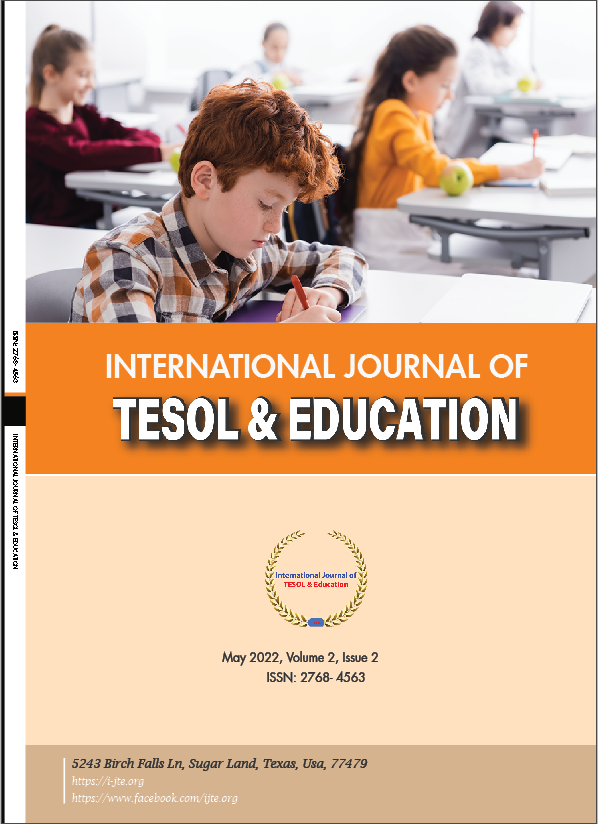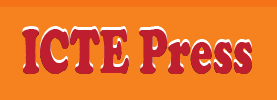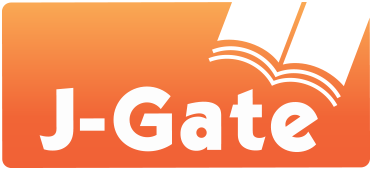Effects of Strategy Instruction on Tertiary Students’ Attitudes towards Learning English Listening Skill: An Action Research Project in Vietnam
DOI:
https://doi.org/10.54855/ijte.22228Keywords:
listening strategy instruction, EFL listening strategies, learners’ attitudesAbstract
Strategy instruction has been proved as an effective method to enhance the listening ability and metacognition of learners of English as a foreign language (EFL). However, little attention has been paid to how listening strategy instruction impacts the learners' attitudes towards their listening learning. This study investigated Vietnamese students' attitudes towards English listening learning after the two cycles of an action research project in which strategy instruction was employed as the intervention. A total of 30 English-majored freshmen students in a university in Vietnam expressed their attitudes through weekly diaries and focus-group interviews. The findings revealed that the students showed positive attitudes towards English listening learning in terms of all three aspects of attitudes, i.e., cognitive, behavioral, and effective. The results of the study suggest that teachers of English should implement strategy instruction in English listening classes to motivate their EFL learners. Moreover, collaboration with the teacher and among partners is advisable.
References
Al-Qahtani, M. F. (2013). Relationship between English language, learning strategies, attitudes, motivation, and student's academic achievement. Education in Medicine Journal, 5(3), 19–30. https://doi.org/10.5959/eimj.v5i3.124
Anderson, J. R. (1983). The architecture of cognition. Taylor & Francis Group.
Anderson, J. R. (2009). Cognitive psychology and it’s implications (7th ed.). World Publishers.
Asmali, M. (2017). Young Learners’ Attitudes and Motivation to Learn English. Novitas-ROYAL (Research on Youth and Language), 11(1), 53–68.
Benson, P. (2011). Autonomy in language learning (2nd ed.). Routledge: Taylor & Francis Group.
Bidabadi, F., & Yamat, H. (2011). The relationship between listening strategies used by Iranian EFL freshman university students and their listening proficiency levels. English Language Teaching, 4(1), 26. https://doi.org/10.5539/elt.v4n1p26
Burns, A. (2010). Doing action research in English language teaching: A guide for practitioners in system. Routledge: Taylor & Francis Group. https://doi.org/10.1016/j.system.2010.06.005
Carrier, K. A. (2003). Improving high school English language learners' second language listening through strategy instruction. Bilingual Research Journal, 27(3), 383–408. https://doi.org/10.1080/15235882.2003.10162600
Cohen, A. D. (2014). Strategies in learning and using a second language. Strategies in Learning and Using a Second Language. 129–181. https://doi.org/10.4324/9781315833200-14
Creswell, J. W. (2009). Research design: qualitative, quantitative, and mixed methods approaches (5th ed.). Sage Publications, Inc.
Cross, J. (2009). Diagnosing the process, text, and intrusion problems responsible for L2 listeners’ decoding errors. Asian EFL Journal, 11(2), 31–53.
Dörnyei, Z., & Griffee, D. T. (2010). Research methods in applied linguistics. TESOL Journal, 1(1). https://doi.org/10.5054/tj.2010.215611
Gardner, R. C. (2005). Attitude / motivation test battery: international AMTB research project. The University of Western Ontario, http://publish.uwo.ca/~gardner/docs/englishamtb.pd.
Graham, S. (2017). Research into practice: Listening strategies in an instructed classroom setting. Language Teaching, 50(1), 107–119. https://doi.org/10.1017/S0261444816000306
Graham, S., & Macaro, E. (2008). Strategy instruction in listening for lower-intermediate learners of French. Language Learning, 58(4), 747–783. https://doi.org/10.1111/j.1467-9922.2008.00478.x
Graham, S., Macaro, E., & Carrier, K. A. (2003). Strategy instruction in listening for lower-intermediate learners of french. Language Learning, 27(4), 747–783. https://doi.org/10.1111/j.1467-9922.2008.00478.x
Griffiths, C. (2013). The Strategy Factor in Successful Language Learning. USA: Oxford University Press.
Ha, G. L., & Ngo, T. C. T. (2021). Challenges in learning listening comprehension via Microsoft Teams among English majors at Van Lang University. International Journal of TESOL & Education, 1(3), 142-175. EOI: http://eoi.citefactor.org/10.11250/ijte.01.03.009
Hasan, A. S. (2000). Learners’ perceptions of listening comprehension problems. Language, Culture and Curriculum, 13(2), 137–153. https://doi.org/10.1080/07908310008666595
Hoang, V. Q. (2021). The Differences of Individual Learners in Second Language Acquisition. International Journal of TESOL & Education, 1(1), 38–46. Retrieved from https://i-jte.org/index.php/journal/article/view/6
Ianos, M. A. (2014). Language attitudes in a multilingual and multicultural context: the case of autochthonous and immigrant students in Catalonia. TDX (Tesis Doctoral En Xarxa). http://www.tdx.cat/handle/10803/132963
Irgin, P., & Erten, I. H. (2020). Exploring the role of strategy instruction: young learners’ listening performance and strategy use. Eurasian Journal of Applied Linguistics, 6(3), 415–441. https://doi.org/10.32601/ejal.834676
Istiyani, E. (2014). Second language learners ’ attitudes and strategies in learning English as a foreign language. Journal Penelitian Humaniora, 15(2), 99–110.
Kemmis, S., & McTaggart, R. (2014). The action research planner. Action Research. Springer. https://doi.org/10.1007/978-981-4560-67-2
Kurita, T. (2012). Issues in second language listening comprehension and the pedagogical implications. Accents Asia (5) 1, 5, 30–44. http://accentsasia.org/5-1/kurita.pdf
Li, Y. (2017). Exploring self-regulated learning (SRL) and listening strategy instruction in a Chinese L2 classroom. PhD Dissertation. The School of Education International and Multicultural Education Department Second Language Acquisition Emphasis.
Little, D. (2007). Language learner autonomy: Some fundamental considerations revisited. Innovation in Language Learning and Teaching, 1(1), 14–29. https://doi.org/10.2167/illt040.0
Macaro, E. (2007). Language learner strategies: Adhering to a theoretical framework. Language Learning Journal, 35(2), 239–243. https://doi.org/10.1080/09571730701599245
Mendelsohn, D. J. (1998). Teaching the language skills. Annual Review of Applied Linguistics, 18, 81–101.
Michael O’Malley, & Chamot, A. U. (1990). Learning strategies in second language acquisition. UK: Cambridge University Press.
Moradi, K. (2013). The impact of listening strategy instruction on academic lecture comprehension: a case of Iranian EFL learners. Procedia - Social and Behavioral Sciences, 70, 406–416. https://doi.org/10.1016/j.sbspro.2013.01.078
Ngo, H. T. T. (2019). Listening comprehension strategy instruction: a review of previous studies. Journal of Science, Ho Chi Minh City University of Education, 16(8), 227–240.
Ngo, N. H. T. (2017). A needs-based integrated EFL listening strategy instruction: a mixed-methods case study at a Vietnamese university. University of Sydney. https://ses.library.usyd.edu.au/handle/2123/16790
Ngo, N. T. H. (2015). Some insights into listening strategies of learners of English as a foreign language in Vietnam. Language, Culture and Curriculum, 28(3), 311–326. https://doi.org/10.1080/07908318.2015.1080721
Nguyen Buu Huan. (2014). Teacher Change in Science Education in a Vietnamese University. PhD dissertation. Massey University, Manawatu, New Zealand.
Nguyen, H. B. T. (2013). English learning strategies of Vietnamese tertiary students. PhD dissertation. Faculty of Education. University of Tasmania.
Nguyen, H. H. (2018). Fostering positive listening habits among EFL learners through the application of listening strategy and sub-skill instructions. Journal of Language Teaching and Research, 9(2), 268. https://doi.org/10.17507/jltr.0902.07
Nogueroles López, M. (2017). Listening strategies instruction: effects on Hong Kong students’ general strategic behaviour. Asian-Pacific Journal of Second and Foreign Language Education, 2(1). https://doi.org/10.1186/s40862-017-0029-8
Oxford, R. L. (1990). Language Learning Strategies: What Every Teacher Should Know (1st ed.). Heinle & Heinle Publishers.
Oxford, R. L. (2017). Teaching and researching: language learning strategies. Teaching and Researching: Language Learning Strategies. Taylor & Francis. https://doi.org/10.4324/9781315838816
Ozeki, N. (2000). Listening strategy instruction for female EFL college students in Japan. PhD dissertation. Indiana University of Pennsylvania.
Siegel, J. (2013). Second language learners’ perceptions of listening strategy instruction. Innovation in Language Learning and Teaching, 7(1), 1–18. https://doi.org/10.1080/17501229.2011.653110
Siegel, J. (2015). Exploring Listening Strategy Instruction through Action Research. Palgrave Macmillan. https://doi.org/10.1057/9781137521903
Simasanggyaporn, N. (2016). The effect oflListening strategy instruction on Thai learners’ self-efficacy, English listening comprehension and reported use of listening strategies. PhD dissertation. University of READING.
Tarhuni, F. A. (2013). Strategies-based instruction and Libyan adult EFL learners : An action research study. PQDT - Global. 345.
Vandergrift, L. (2004). Listening to learn or learning to listen? Annual Review of Applied Linguistics, 24, 3–25. https://doi.org/10.1017/s0267190504000017
Vandergrift, L, & Goh, C. C. M. (2012). Teaching and learning second language listening: metacognition in action. Teaching and Learning Second Language Listening: Metacognition in Action, 1–316. https://doi.org/10.4324/9780203843376
Vandergrift, L, & Tafaghodtari, M. H. (2010). Teaching L2 learners how to listen does make a difference: an empirical study. Language Learning, 60(2), 470–497. https://doi.org/10.1111/j.1467-9922.2009.00559.x
Vandergrift, L. (1997). The comprehension strategies of second language (French) listeners: A descriptive study. Foreign Language Annals, 30(3), 387–409. https://doi.org/10.1111/j.1944-9720.1997.tb02362.x
Walker, D. A., Smith, M. C., & Hamidova, N. I. (2013). A structural analysis of the attitudes toward science scale: students’ attitudes and beliefs about science as a multidimensional composition. 38 Multiple Linear Regression Viewpoints, 39(1999), 38–48.
Wang, W. (2016). Learning to Listen: The Impact of a Metacognitive Approach to Listening Instruction. Asia-Pacific Education Researcher, 25(1), 79–88. https://doi.org/10.1007/s40299-015-0235-4
Webb, T. (2017). Effects of a metacognitive approach to teaching L2 listening. Thesis report. Faculty of Education and Society, Malmo Hogskola.
Wesely, P. M. (2012). Learner attitudes, perceptions, and beliefs in language learning. Foreign Language Annals, 45(1), 98–118. https://doi.org/10.1111/j.1944-9720.2012.01181.x
Yeldham, M., & Gruba, P. (2016). The development of individual learners in an L2 listening strategies course. Language Teaching Research, 20(1), 9–34. https://doi.org/10.1177/1362168814541723
Zobler, A. C. (2010). Effects of listening strategy instruction on listening comprehension, oral proficiency, and metacognition on second language learners. PhD Dissertation. Southern Connecticut State University.
Downloads
Published
Issue
Section
License
Copyright (c) 2022 Ngo Thi Thanh Huyen

This work is licensed under a Creative Commons Attribution 4.0 International License.
The copyright of all articles published in the International Journal of TESOL & Education (ijte) remains with the Authors, i.e. Authors retain full ownership of their article. Permitted third-party reuse of the open access articles is defined by the applicable Creative Commons (CC) end-user license which is accepted by the Authors upon submission of their paper. All articles in the ijte are published under the CC BY-NC 4.0 license, meaning that end users can freely share an article (i.e. copy and redistribute the material in any medium or format) and adapt it (i.e. remix, transform and build upon the material) on the condition that proper attribution is given (i.e. appropriate credit, a link to the applicable license and an indication if any changes were made; all in such a way that does not suggest that the licensor endorses the user or the use) and the material is only used for non-commercial purposes.
Authors retain copyright and grant the journal the right of first publication with the work simultaneously licensed under a Creative Commons Attribution 4.0 International License that allows others to share the work with an acknowledgment of the work's authorship and initial publication in this journal.
Authors are able to enter into separate, additional contractual arrangements for the non-exclusive distribution of the journal's published version of the work (e.g., post it to an institutional repository, in a journal or publish it in a book), with an acknowledgment of its initial publication in this journal.











